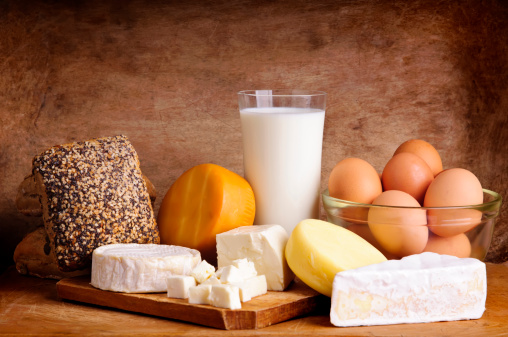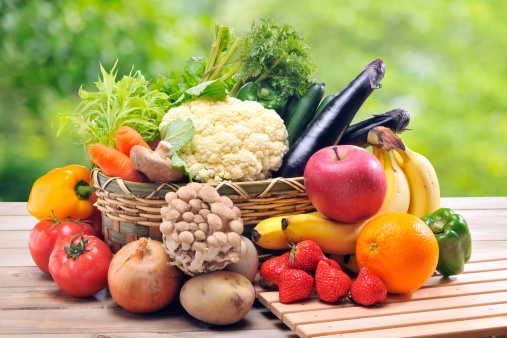Lesson 1: Predisposition, Biological Factors, and the Brain
The Brain and Nutrition
Our biological health requires basic nutrition; one of our fundamental needs is food. Food and drink, however, can be healthy or unhealthy. A child raised on hot dogs and soft drinks would be lacking in complete and balanced nutrition. The body (especially the brain) needs special materials for it to operate effectively. Like a car that needs oil, gas, and antifreeze to operate, our bodies need vitamins, minerals, and glucose. Our bodies are more particular, however. Too much or too little of a vitamin, for instance, can result in problems with our development. Some vitamins are water-soluble (e.g., vitamin C); if we ingest too much, we excrete what we do not use (usually in our urine). Other vitamins are fat-soluble (e.g., vitamin D). If we ingest too much, we gradually build up toxic levels of the compound in our fat cells. See Table 6.1 for specific examples.
TABLE 6.1
|
Vitamin |
Foods |
Symptoms |
|
A fat soluble |
Found in fish liver oils, liver, egg yolks, butter, cream, green leafy vegetables, and yellow vegetables. |
In childhood, a severe deficiency may cause problems with the cornea (part of the eye), night blindness, and in extreme cases, total and permanent blindness. Too little can also cause dry skin in adults. Too much vitamin A may result in sparse coarse hair, dry rough skin, cracked lips, severe headache, vomiting, joint pain, and generalized weakness. |
|
D fat soluble |
While this vitamin is naturally found in fish liver oils and egg yolks, it has been added to most milk. This vitamin is formed in human skin by exposure to sunlight (ultraviolet radiation). |
Bone development problems arise with a lack of vitamin D. Walking may be painful and rickets may develop. Too much of this vitamin may cause constipation, loss of appetite, and headache. |
|
E fat soluble |
Found in plant oils (vegetable oil, margarine, salad dressings), dark green and leafy vegetables, whole grain cereal products, liver, egg yolks, milk fat, nuts, seeds, and butter. |
To have too much or too little of this vitamin is rare. In extreme deprivation some red blood cells may rupture. With an overdose of this vitamin, some people may experience intestinal disturbances. |
|
K fat soluble |
Vegetables provide the major amount of this vitamin in the diet, but nutritionists have assumed that people absorb more from oil or oil-based supplements than from vegetables. |
Deficiency may interfere with the process of blood clotting. Too much of this vitamin in infancy may cause jaundice. |
|
|
|
|
|
C water soluble |
Fruits (especially citrus) and vegetables are the best sources. |
Lack of this vitamin causes scurvy; one major result of scurvy is the failure of wounds to heal. Lack of vitamin C also stops bone growth. Too much vitamin C may increase the likelihood of kidney stones, the destruction of vitamin B12, and diarrhea. |
|
B12 water soluble |
Animal products are the best source. Vegetables do not provide adequate B12 vitamins. |
Too little B12 causes pernicious anemia. A person may experience a loss of sensation in the fingers and toes. B12 has low toxicity and, generally speaking, no negative results occur from too much of this vitamin. |
|
B1 (thiamine) water soluble |
Found in brewers yeast, pork, sunflower seeds, peas, and beans |
A deficiency in thiamine results in lower glucose utilization by the nervous system, degeneration of the myelin sheaths of certain nerve fibres, a weakened heart muscle, beriberi, and constipation. Too much of this vitamin, if injected, can cause a nervous system hypersensitivity reaction. |
|
B3 (niacin) water soluble |
Tuna, chicken, beef, and many other foods contain niacin. |
A lack of niacin can result in muscle weakness, decreased glandular secretions, and inflammation of the gastro-intestinal tract. Too little can also cause a skin rash on areas exposed to the sun. Too much niacin can result in “niacin flush” (reddening of the skin), heartburn, nausea, diarrhea, fainting, and liver malfunction. |
|
B2 (riboflavin) water soluble |
Foods high in riboflavin include milk, yogurt, cheese, meat, leafy green vegetables, whole and enriched grains. Riboflavin is an essential vitamin and is easily destroyed by light. Oral contraceptives may cause riboflavin deficiency as well. |
With low levels of riboflavin, people may experience cracking at the corners of the mouth, burning eyes, depression, headaches, and forgetfulness. No cases of toxicity are reported regarding this vitamin. Note: Riboflavin can be destroyed by light. Do not keep milk in clear containers in the light! |
|
Folate (one of the B vitamins) water soluble |
Folic acid, also called folacin, is found in spinach, asparagus, turnip greens, lima beans, beef liver, parsley, broccoli, and romaine lettuce. |
Low levels of folic acid have negative consequences for developing fetuses because folate is necessary for the production and maintenance of new cells. This is especially important during periods of rapid cell division and growth such as infancy and pregnancy. Folate is needed to make DNA and RNA, the building blocks of cells. It also helps prevent changes to DNA that may lead to cancer. Both adults and children need folate to make normal red blood cells and to prevent anemia. Low folate in utero is linked to spina bifida. Negative effects have not been found with too much folate. |
|
B6 (pyridoxine) water soluble |
This vitamin can be found in fortified cereals, beans, meat, poultry, fish, and some fruits and vegetables. |
Low levels of this vitamin can cause anemia as well as a decrease in antibody production and suppression of the immune system. Some people may also experience dermatitis, a sore tongue, depression, and confusion. Too much B6 can cause neurological damage. |
Some vitamins and minerals required by our bodies are not naturally produced by our bodies. Using the food we eat, the body must manufacture these substances that include proteins and fats. The body does this by digesting the proteins and fats in food to make special proteins and fats for our brains to use. Not all fats are created equal, however. The “good” fats or lipids include the omega-3 and omega-6 fats. Low levels of such fats can cause visual problems as well as problems in motivation and motor co-ordination.
 |
 |
 |
As referred to previously, neurotransmitters are an important part of brain functioning. Certain foods contain essential components responsible for the functioning of neurotransmitters. If a person’s diet is lacking in the required foods, neurological and emotional disorders may occur. See Table 5.5 for examples of some essential components.
TABLE 6.2.
|
Essential Component |
Used to Make | Source |
| Aspartic Acid | Aspartate | Peanuts, potatoes, eggs, and grains |
| Choline | Acetylcholine | Eggs, liver, and soybeans |
| Glutamic Acid | Glutamate | Flour and potatoes |
| Phenylalanine | Dopamine | Beets, soybeans, almonds, eggs, meat, and grains |
| Tryptophan | Serotonin | Eggs, meat, skim milk, bananas, yogurt, milk, and cheese |
| Tyrosine | Norepinephrine | Milk, meat, fish, and legumes |
|
Causes of vitamin and mineral deficiencies are varied.
|
The nutrition of a pregnant woman is important to the development of her fetus. Proper nutrition during the first two years of life is also important. Malnutrition during either of these periods of rapid brain growth may result in developmental difficulties, some of which are not reversible. In addition to proper nutrition, people need to avoid non-nutritive substances that may lead to addiction. The addicted brain is a complicated subject – neurobiologists have known for a long time that certain substances (alcohol, cocaine, even sugar) induce the activity of the brain’s reward system so much so that individuals may do anything to get a “fix” or “hit” of a drug, even at the expense of eating and sleeping! Addiction is discussed further in subsequent lessons.
